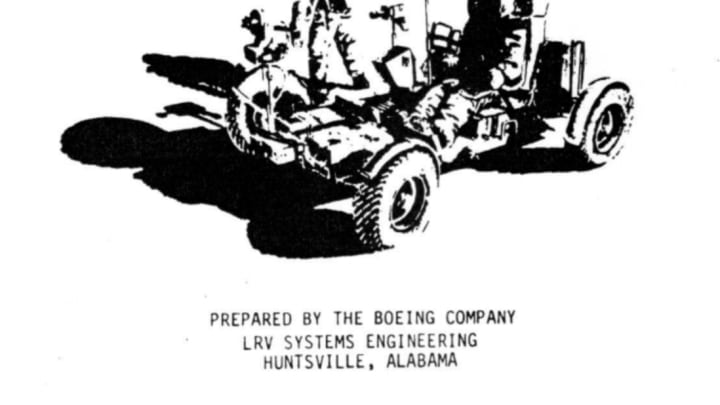Most people don’t read the operating booklet stashed in their car’s glove compartment, but you might want to take the time to check out NASA’s handbook [PDF] for its Lunar Roving Vehicle—you know, just in case.
Completed in 1971, the LRV was built by Boeing and General Motors to withstand the unique conditions of the moon. This means it had wire-mesh tires powered by four separate electric motors, a navigational device that used the sun azimuth to calculate directional course, and dust guards…lots and lots of dust guards.
(Worth reminding ourselves here that GM was making electric cars as early as the 1970s but you had to go to the moon to drive them.)

This operations handbook [PDF], published in April 1971, is surprisingly concise and relatively straightforward considering it contains instructions for a dang moon buggy. There are a few reminders of the downright wacky conditions the drivers would face on the moon, like how the 470 lb. rover will only weigh 85 lbs. on the lunar surface, meaning crew members could use “outboard handholds…to lift, move, and tow the LRV to any desired location.”
Also featured in the manual is an odometer quirk that will be familiar to anyone who has stolen his father’s car to play hooky around Chicago with his best friend and his best friend’s girlfriend: “The odometer logic cannot distinguish between forward and reverse wheel rotation. Therefore, reverse operation of the LRV adds to the odometer reading.”
Most importantly, though, the handbook contains pragmatic flowcharts with logical fixes for brake, steering, power, or wheel problems (wheels could go "flat," meaning the wire mesh could loosen or fray). However, there is no information on what to do if astronauts experienced a total breakdown while operating the rover far from the lunar module. It goes unmentioned in this guide, but NASA had a policy in place to prevent this: Don’t drive beyond a point from which you can walk back.
Astronauts never had to hoof it, as the LRVs performed exquisitely during the three Apollo missions on which they were deployed. On its first mission—Apollo 15—the rover traversed over 17 miles total with no major issues. It's still up there (coordinates 26.10°N 3.65°E), in case you're in the market for a lightly used lunar rover—you already have the instruction booklet.
